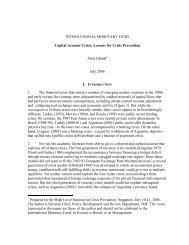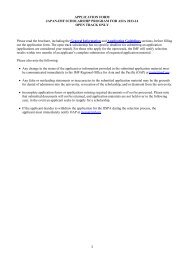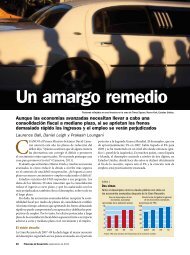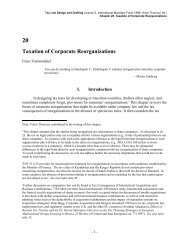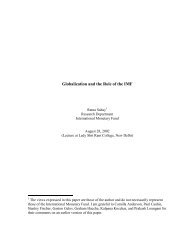Insolvency â why a special regime for banks? by Eva Hupkes ... - IMF
Insolvency â why a special regime for banks? by Eva Hupkes ... - IMF
Insolvency â why a special regime for banks? by Eva Hupkes ... - IMF
Create successful ePaper yourself
Turn your PDF publications into a flip-book with our unique Google optimized e-Paper software.
study group to look into the supervisory, legal and financial problems arising from such<br />
events. The study group issued fourteen recommendations <strong>for</strong> strengthening the legal and<br />
regulatory frameworks <strong>for</strong> dealing with this type of insolvency. 131 Apart from recognizing the<br />
need <strong>for</strong> enhanced cooperation among authorities, these recommendations focus mainly on<br />
improving the legal framework <strong>for</strong> netting. The G10 Study of Financial Sector<br />
Consolidation 132 , which was released to the public in January, 2001, pointed out the issues<br />
arising from the creation of increasingly complex financial groups, the failure of which would<br />
have damaging effects on the world financial system. To minimize those consequences, the<br />
report concluded that it would be necessary to step up contingency planning and to improve<br />
communication and cooperation among central <strong>banks</strong>, finance ministries and other financial<br />
supervisors, domestic and international. The study, however, provides no details on how such<br />
communication and cooperation would take place and what would actually need to be done to<br />
deal effectively with a large financial group in distress.<br />
So far, little progress has been made in the implementation of those calls <strong>for</strong> action. This may<br />
be due to the very complexity of the matter and to the divergent interests and overlapping<br />
competencies involved. As we have seen above, devising a legal framework <strong>for</strong> bank<br />
insolvency is already complex enough on a national level, with the various authorities<br />
involved – regulatory, supervisory and judicial - the complexity is even greater in an<br />
international context.<br />
In like manner, the differences between general insolvency law and bank regulatory rules are<br />
even more striking in the international context. National insolvency rules are based<br />
predominantly on the principle of territoriality, whereas in banking regulation the principles<br />
of consolidated supervision apply. <strong>Insolvency</strong> measures, such as moratoria, apply only within<br />
the jurisdiction where the measure was imposed. The extent to which <strong>for</strong>eign authorities will<br />
recognize these measures depends on local law. While some jurisdictions recognize an<br />
insolvency decree issued abroad against the head office and allow assets of local branches to<br />
be included in the <strong>for</strong>eign proceedings (single entity or universal approach), other<br />
jurisdictions take a more restrictive view and liquidate local branches of the <strong>for</strong>eign bank as<br />
separate entities with the intent to pay out local creditors first (separate entity approach). In<br />
such a case, creditors may be treated differently depending upon whether they have business<br />
relations with the head office or a <strong>for</strong>eign branch. 133<br />
131 Group of Thirty, International Insolvencies in the Financial Sector, A Study Group Report,<br />
1998.<br />
132 In September 1999 Finance Ministers and central bank Governors of the Group of Ten<br />
asked their Deputies to conduct a study of financial consolidation and its potential effects. To<br />
conduct the study, a Working Party was established under the auspices of finance ministry<br />
and central bank deputies of the Group of Ten. Group of Ten, Report on Consolidation in the<br />
Financial Sector, Jan. 25, 2001, available via the Internet at<br />
http://www.imf.org/external/np/g10/2001/01/Eng/.<br />
133 See Hüpkes, supra note 36, at 142 et seq.<br />
28





